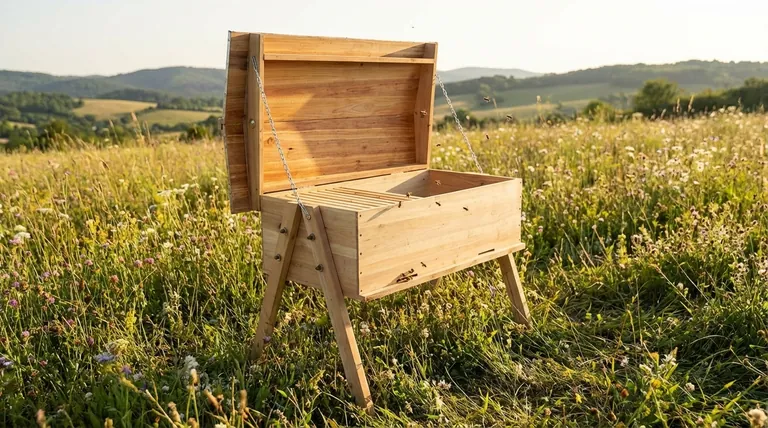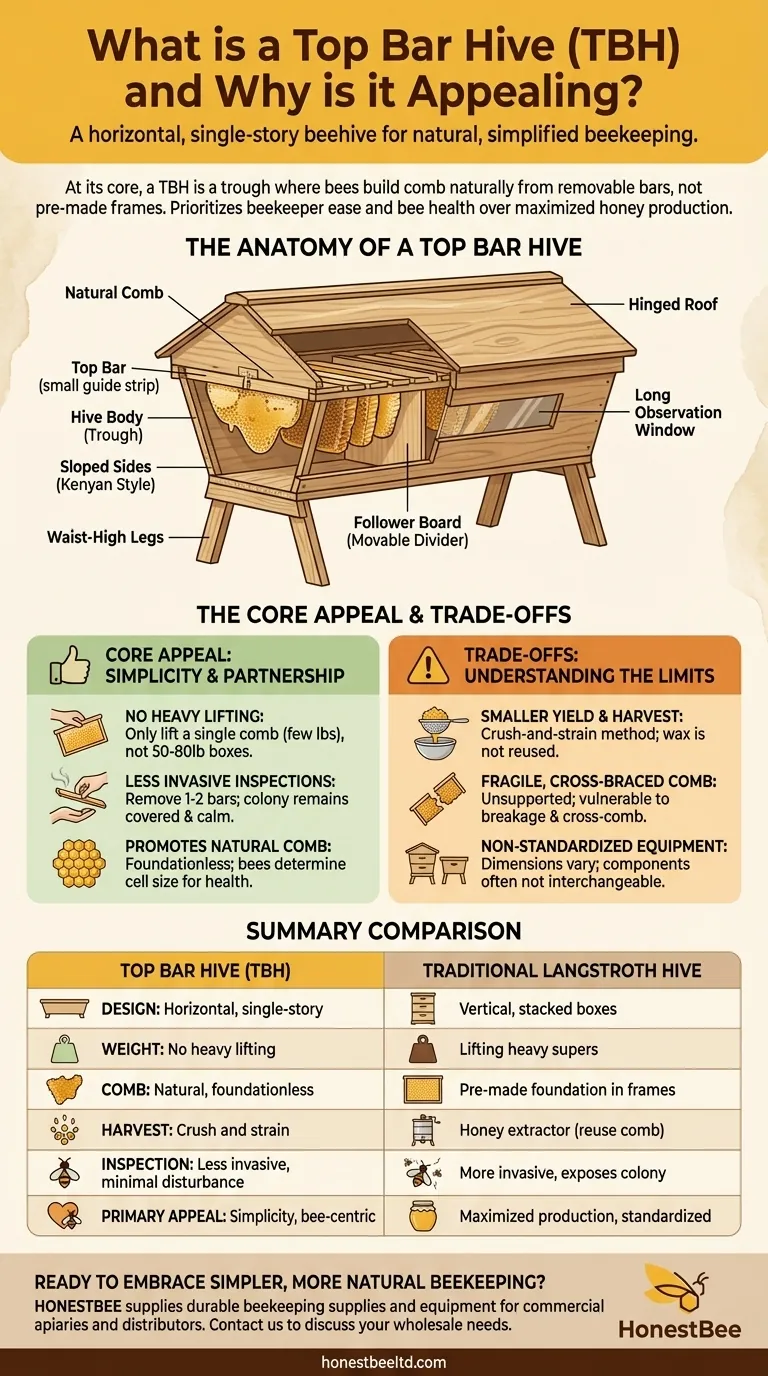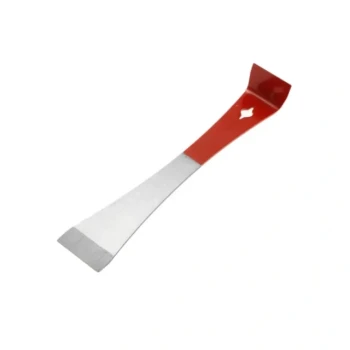At its core, a top bar hive (TBH) is a single-story, horizontal beehive where bees build their comb naturally, hanging from removable wooden bars instead of within pre-made frames. Its appeal comes from a radically simplified approach to beekeeping that eliminates heavy lifting, reduces startup costs, and is less invasive for the bees during inspections.
The decision to use a top bar hive is less about equipment and more about adopting a specific beekeeping philosophy. It prioritizes the beekeeper's physical ease and a more natural environment for the bees over the maximized honey production associated with traditional vertical hives.

The Anatomy of a Top Bar Hive
A TBH is defined by its horizontal layout and simple components. Understanding its structure reveals why it functions so differently from a typical stacked-box hive.
The Hive Body
The main body is a long, horizontal trough. It is most often the Kenyan style, which has sloped sides. This angle discourages bees from attaching their comb to the hive walls, making each bar easier to remove.
The entire hive is typically raised on legs to a comfortable, waist-high working level. This design completely eliminates the need for bending or crouching during hive management.
The Top Bars
Instead of complex frames with pre-installed foundation, a TBH uses simple wooden bars that sit across the top of the hive body. Bees build their comb directly downward from a guide on the underside of each bar, creating their own cell sizes and structures naturally.
The Follower Board
A follower board is a solid divider, shaped like the hive's cross-section, that can be moved along the length of the hive. It acts as a movable wall, allowing you to easily adjust the interior space to match the colony's size, which is crucial for temperature regulation and pest management.
The Roof and Optional Features
A simple roof protects the hive from the elements. Many designs feature a hinged lid for easy access. Beekeepers often add features like a long observation window on the side, which allows for a quick check on colony health without disturbing the bees at all.
The Core Appeal: A Different Beekeeping Philosophy
Choosing a top bar hive means embracing a management style focused on simplicity and partnership with the bees.
Eliminating Heavy Lifting
The most cited benefit is the complete absence of heavy lifting. Traditional hives require you to lift boxes (supers) that can weigh 50-80 pounds. With a TBH, the heaviest object you ever lift is a single comb of honey, which weighs only a few pounds.
Less Invasive Inspections
To inspect a TBH, you gently smoke the bees and remove only one or two bars at a time. The rest of the colony remains covered and calm. This contrasts sharply with vertical hives, where removing the roof exposes the entire top of the colony at once, causing a much greater disturbance.
Promoting Natural Comb Building
Top bar hives operate without foundation—the pre-printed wax or plastic sheets used in standard frames. This allows bees to build their own comb with cell sizes they determine, including the larger drone cells they need. This "natural comb" approach is a cornerstone of treatment-free and natural beekeeping practices.
Understanding the Trade-offs
While appealing, the TBH design comes with significant trade-offs that are critical to understand before you commit.
Honey Yield and Harvest Method
Honey harvests from a TBH are typically smaller than from a traditional Langstroth hive. The harvest method is also different. You cut the comb from the bar and use a crush-and-strain method to separate the honey from the wax.
This process is simple but means the bees must rebuild that comb from scratch, consuming resources that could have been used for honey storage. In contrast, honey extractors used with standard frames keep the comb intact for reuse.
Fragile, Cross-Braced Comb
The lack of a four-sided frame means the comb is only supported at the top. It can be extremely fragile, especially when new or in hot weather. Careless handling can easily break a comb, which is a major setback for the colony.
Bees will also sometimes build cross comb, connecting one bar to an adjacent one. This can make inspections difficult and requires careful intervention to correct.
Non-Standardized Equipment
The flexibility of the TBH is also a drawback. Dimensions are not standardized across manufacturers. This means top bars from one hive may not fit another, and you cannot easily exchange combs of brood or honey with other beekeepers unless they use an identical design.
Is a Top Bar Hive Right for You?
Choosing a hive system depends entirely on your personal goals as a beekeeper.
- If your primary focus is easy physical management: The top bar hive is an excellent choice, especially if you have back problems or other physical limitations.
- If your primary focus is low startup cost and DIY potential: The simple design of a TBH makes it far easier and cheaper to build yourself than a standard hive.
- If your primary focus is a "natural" or "bee-centric" approach: The foundationless, low-intervention nature of the TBH aligns perfectly with this philosophy.
- If your primary focus is maximizing honey production: A traditional Langstroth hive is a more effective tool due to its expandability and use of extractors that preserve comb.
Ultimately, the top bar hive offers a rewarding and accessible path into beekeeping that prioritizes the experience of both the beekeeper and the bees.
Summary Table:
| Feature | Top Bar Hive (TBH) | Traditional Langstroth Hive |
|---|---|---|
| Design | Horizontal, single-story | Vertical, stacked boxes |
| Weight Management | No heavy lifting; ideal for physical limitations | Requires lifting heavy supers (50-80 lbs) |
| Comb Building | Natural, foundationless comb | Pre-made foundation in frames |
| Harvest Method | Crush and strain (wax is not reused) | Honey extractor (comb is reused) |
| Inspection Style | Less invasive; minimal disturbance | More invasive; exposes entire top of colony |
| Primary Appeal | Simplicity, bee-centric philosophy, physical ease | Maximized honey production, standardized equipment |
Ready to Embrace Simpler, More Natural Beekeeping?
Whether you're a commercial apiary focused on bee health or a distributor seeking innovative equipment, the top bar hive represents a growing trend in sustainable apiculture. HONESTBEE supplies the durable beekeeping supplies and equipment you need to succeed.
We provide wholesale-focused solutions for commercial apiaries and beekeeping equipment distributors. Let us help you equip your operation with the right tools for a modern, bee-friendly approach.
Contact HONESTBEE today to discuss your wholesale needs and discover how our equipment can benefit your business.
Visual Guide

Related Products
- Long Langstroth Style Horizontal Top Bar Hive for Wholesale
- Top Bar Beehive for Beekeeping Wholesales Kenya Top Bar Hive
- HONESTBEE Professional Multi-Functional Hive Tool with Ergonomic Wood Handle
- HONESTBEE Advanced Ergonomic Stainless Steel Hive Tool for Beekeeping
- HONESTBEE Professional Long Handled Hive Tool with Precision Cutting Blade
People Also Ask
- What is a top bar bee hive? A Natural, Low-Stress Beekeeping Solution
- How are entrances designed in top bar hives? Master Beehive Layout for Maximum Honey
- What are the advantages of a top bar hive? Simpler, Bee-Centric Beekeeping for All
- What are the main differences between Langstroth hives and top bar hives? Choose the Right Hive for Your Beekeeping Goals
- How does the design of a top bar hive benefit beekeepers? Ergonomic & Natural Beekeeping for Hobbyists



















